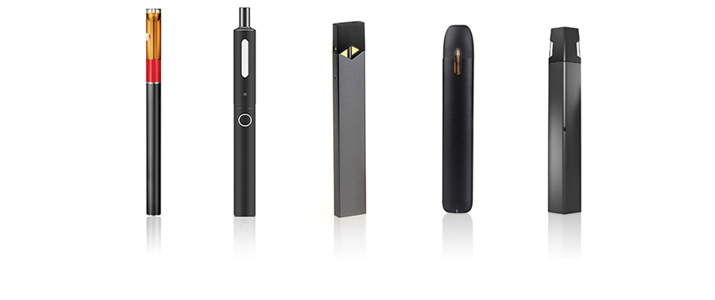FDA Launches New Campaign: "The Real Cost" Youth E-Cigarette Prevention Campaign
In 2014, e-cigarettes surpassed combustible cigarettes as the most commonly used tobacco product among U.S. middle and high school students reporting current tobacco use. By 2017, more than 2 million teens were currently using e-cigarettes, and parents, teachers, and school administrators across the nation began raising alarm about pervasive e-cigarette use in schools due to the rising popularity of products with high nicotine levels and low aerosol emissions, like JUUL.
JUUL claims to contain as much nicotine as a pack of regular cigarettes in a single “pod,” and even e-cigarettes labeled as “nicotine-free” can still expose users to toxic chemicals known to cause serious health effects.1-7 However, awareness of these potential health risks remains low, with about 80 percent of youth saying they do not see great risk of harm from regular use of e-cigarettes.8 For youth, this low-risk mentality could have devastating consequences. Teens' brains are still developing, making them especially vulnerable to nicotine addiction.9 In fact, nicotine can “rewire” the brain to crave more nicotine, and some research suggests these changes could be permanent.10 Further, emerging evidence suggests e-cigarette use may be harmful to the lungs,11-13 and more research is needed to understand the long-term consequences of using e-cigarettes.
As part of FDA's ongoing efforts to protect youth from the dangers of tobacco use, the agency is expanding its successful youth tobacco prevention campaign, “The Real Cost,” to reach the more than 10 million youth ages 12-17 who have used e-cigarettes or are open to trying them. The campaign urges these teens to “know the real cost of vaping,” with advertising designed to snap teens out of their “cost-free” mentality by educating youth about the potential risks of using e-cigarettes.
The campaign will reach teens where they spend most of their time: in school and online. In addition to a suite of digital content on “The Real Cost” campaign website and social media channels, new ads will run on digital platforms where age is verified, including Hulu, Facebook, Spotify, and YouTube. As teens are increasingly faced with peer-pressure to use e-cigarettes when they are in the school environment, the campaign will also place e-cigarette prevention materials in high schools across the nation, both in school bathrooms and on educational digital platforms accessed by students during the school day. Additional materials for students and educators will be distributed to schools in collaboration with Scholastic and Students Against Destructive Decisions (SADD).
“The Real Cost” Youth E-Cigarette Prevention Campaign is FDA's fourth youth tobacco prevention campaign since 2014. The agency's other campaigns include “The Real Cost” Smoking Prevention Campaign; “The Real Cost” Smokeless Tobacco Prevention Campaign; and “Fresh Empire,” a multicultural tobacco prevention campaign. FDA's campaigns are based on the best available science and are evaluated to measure effectiveness in changing tobacco-related knowledge, attitudes, and beliefs over time.
Find more information about FDA's public education campaigns on the agency's website, and learn what other actions FDA has taken to keep tobacco products out of the hands of youth.
1. Rubinstein M, Delucchi K, Benowitz N, Ramo D. Adolescent exposure to toxic volatile organic chemicals from e-cigarettes. Pediatrics. 2018; 141(4):e20173557.
2. Goniewicz ML, Knysak J, Gawron M, et al. Levels of selected carcinogens and toxicants in vapour from electronic cigarettes. Tobacco Control. 2014; 23(2):133-139.
3. Cheng T. Chemical evaluation of electronic cigarettes. Tobacco Control. 2014; 23:ii11–ii17.
4. Bein K, Leikauf GD. Acrolein–a pulmonary hazard. Molecular Nutrition & Food Research. 2011;55(9):1342-1360.
5. Occupational Safety and Health Administration (OSHA). Occupational Safety and Health Standards. Medical surveillance – Formaldehyde. Washington, DC: U.S. Department of Labor, Occupational Safety and Health Administration. https://www.osha.gov/pls/oshaweb/owadisp.show_document?p_table=STANDARDS&p_id=10078. Accessed May 8, 2018.
6. Williams M, Villarreal A, Bozhilov K, Lin S, Talbot P. Metal and silicate particles including nanoparticles are present in electronic cigarette cartomizer fluid and aerosol. PLoS One. 2013; 8(3):e57987.
7. Olmedo P, Goessler W, Tanda S, et al. Metal concentrations in e-cigarette liquid and aerosol samples: the contribution of metallic coils. Environmental Health Perspectives (Online). 2018; 126(2).
8. Johnston, L. D., Miech, R. A., O'Malley, P. M., Bachman, J. G., Schulenberg, J. E., & Patrick, M. E. (2018). Monitoring the Future national survey results on drug use: 1975-2017: Overview, key findings on adolescent drug use. Ann Arbor: Institute for Social Research, The University of Michigan.
9. U.S. Department of Health and Human Services (USDHHS). A Report of the Surgeon General: Preventing Tobacco Use among Youth and Young Adults. We Can Make the Next Generation Tobacco-Free (Consumer Booklet). Atlanta, GA: U.S. Department of Health and Human Services, Centers for Disease Control and Prevention, National Center for Chronic Disease Prevention and Health Promotion, Office on Smoking and Health; 2012.
10. U.S Department of Health and Human Services (USDHHS). A Report of the Surgeon General: How Tobacco Smoke Causes Disease: What It Means to You (Consumer Booklet). Atlanta, GA: U.S. Department of Health and Human Services, Centers for Disease Control and Prevention, National Center for Chronic Disease Prevention and Health Promotion, Office on Smoking and Health; 2010.
11. National Academies of Sciences, Engineering, and Medicine (NASEM). 2018. Public Health Consequences of E-cigarettes. Washington, DC: The National Academies Press. Doi: https://10.17226/24952
12. Sommerfeld CG, Weiner DJ, Nowalk A. Larkin A. Hypersensitivity Pneumonitis and Acute Respiratory Distress Syndrome From E-Cigarette Use. Pediatrics. 2018; 141(6):e20163927.
13. Khan, MS, Khateeb F, Akhtar J, Khan Z, Lal A, Kholodovych V, Hammersley J. Organizing pneumonia related to electronic cigarette use: A case report and review of literature. The clinical respiratory journal. 2018; 12(3):1295-1299.


